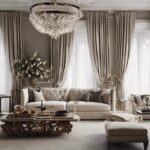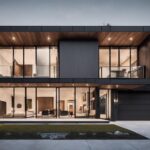Architecture Home Styles
7 Key Differences Between Old House and Modern House
Uncover the surprising contrasts between old and modern houses that challenge conventional perceptions – prepare for a revelation in architectural evolution.
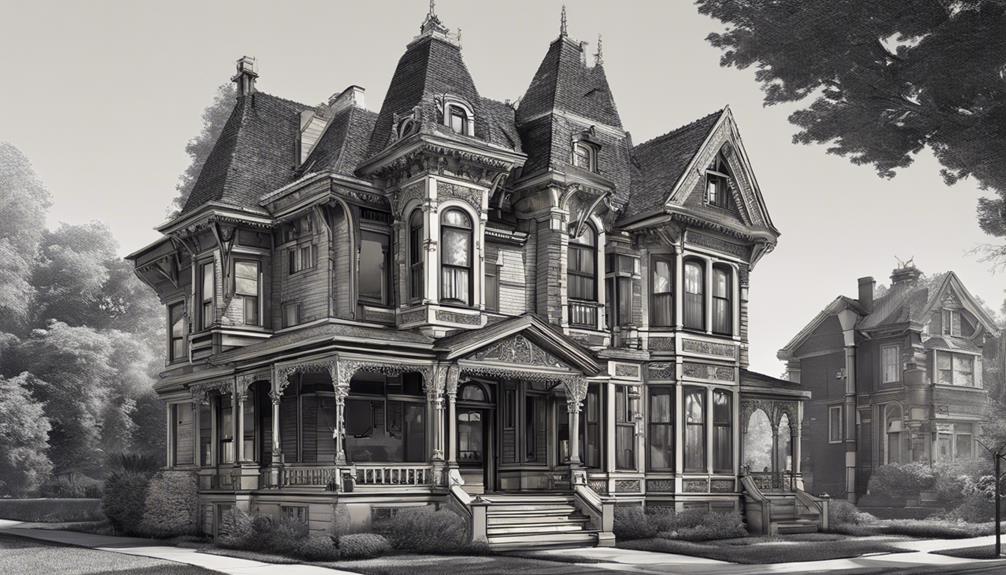
As we navigate the architectural realm, exploring the stark disparities between old houses and modern dwellings is akin to comparing a vintage wine to a contemporary craft beer.
Each has its unique flavor and allure, drawing distinct sets of admirers. However, the intricacies that set these housing styles apart run deeper than mere aesthetics.
Unveiling these seven key differences may just reshape your perspective on what truly makes a house a home.
Key Takeaways
- Modern homes prioritize innovation, sustainability, and efficiency, while traditional homes embrace historical styles and intricate details.
- Modern houses feature advanced technology like smart home systems and energy-efficient appliances, while older homes may lack these modern conveniences.
- Modern homes have stronger foundation integrity and adhere to strict building codes for safety, while older homes may require upgrades to meet contemporary standards.
- Modern houses excel in energy efficiency with superior insulation and sustainable design, while older homes may lack modern energy-saving elements.
Architectural Style Differences
When comparing old and modern houses, the architectural style differences showcase a fascinating evolution in design principles and material choices. Traditional homes, rooted in styles like Victorian, Colonial, Craftsman, and Neoclassical, embody classic design elements, distinct room separation, and intricate details. These houses often emphasize figures and mathematics in design, reflecting a rich historical and cultural background.
On the other hand, modern homes embrace innovation and sustainability, favoring efficient space utilization and industrial materials such as steel and concrete. The shift towards modern architecture highlights a departure from the past, focusing on clean lines, functionality, and simplicity. Unlike traditional homes that rely on locally available materials, modern houses prioritize advanced materials and technologies for construction.
This transition signifies a move towards more sustainable and eco-friendly practices, where design meets efficiency in a harmonious blend of aesthetics and practicality. The juxtaposition of traditional and modern architecture not only reflects changing societal needs but also demonstrates the continuous evolution of architectural styles towards a more innovative and sustainable future.
Technology and Amenities Variances

In modern housing, the disparities in technology and amenities between old and contemporary residences are stark, influencing daily living experiences significantly. Modern homes boast advanced features like smart home systems, energy-efficient appliances, and integrated security systems, providing convenience and peace of mind.
Central heating, smart thermostats, and energy-efficient lighting are standard in modern houses, ensuring comfort and cost savings. High-speed internet connectivity is a common inclusion, along with automated lighting controls for effortless customization.
On the other hand, old houses may lack these modern conveniences, necessitating upgrades for enhanced living. Retrofitting with amenities like home theaters, automated blinds, and remote-controlled ceiling fans can bridge the technology gap. The absence of such features in older homes can impact comfort, convenience, and energy efficiency, highlighting the importance of modernizing living spaces to align with contemporary standards.
Structural Integrity Variances
Old houses often showcase differences in foundation strength, roofing materials, and wall construction techniques compared to modern counterparts. These variances can significantly impact the overall structural integrity and durability of a home.
Understanding these key points is crucial when considering the maintenance and potential upgrades needed for both old and modern houses.
Foundation Strength Differences
With advancements in construction techniques and materials, modern houses exhibit significantly stronger foundation integrity compared to their older counterparts. Here are some key differences in foundation strength between old and modern houses:
- Materials Used: Modern house foundations often incorporate reinforced concrete and steel, providing superior strength and durability.
- Potential Issues: Old house foundations, typically made of stone, brick, or wood, are more susceptible to settling, cracks, and decay over time.
- Structural Integrity: Modern homes adhere to stringent building codes that demand higher standards for foundation strength, ensuring long-term stability and safety.
- Longevity: The use of advanced construction techniques in modern houses increases the lifespan of the foundation, reducing the risk of structural problems in the future.
Roofing Materials Evolution
Utilizing cutting-edge materials and innovative techniques, modern roofing systems have undergone a remarkable evolution, enhancing structural integrity and longevity in contemporary homes.
Unlike traditional homes that often relied on wood shingles, slate, or clay tiles, modern houses embrace advanced materials like asphalt shingles, metal roofing, and solar panels. These newer roofing options offer improved durability and energy efficiency, making them ideal choices for today's homeowners.
The shift towards these materials has significantly enhanced weather resistance, ensuring that modern house roofs can withstand harsh conditions better than those of older homes.
With superior durability and energy efficiency, modern roofing materials not only contribute to the overall structural integrity of a house but also reduce the need for frequent repairs and maintenance.
Wall Construction Techniques
Embracing advancements in construction methods, the evolution of wall construction techniques between old and modern houses showcases notable variances in structural integrity.
- Old houses boast solid masonry walls of brick or stone, ensuring exceptional strength but demanding significant maintenance efforts.
- Modern homes opt for timber or steel frame construction with insulation, offering energy efficiency and quicker assembly.
- Traditional methods in old houses are labor-intensive and costly to modify due to heavy materials, impacting overall expenses.
- Modern approaches prioritize prefabrication, reducing construction time and costs while providing flexibility in aesthetics and maintenance requirements.
The choice between these techniques hinges on factors like desired design, ease of upkeep, and budget considerations, highlighting the dynamic shift towards innovation in modern construction practices.
Energy Efficiency Contrasts

In comparing old and modern houses, differences in energy efficiency become evident through advancements in window technology and insulation. Modern houses typically feature thicker, dual-pane windows and superior insulation, enhancing energy efficiency. This contrasts with older homes that often lack these modern energy-efficient elements, such as built-in solar panel systems commonly found in new homes.
The design of newer homes prioritizes heat retention in winter and cooling in summer, ultimately reducing overall energy consumption. Not only does energy efficiency benefit homeowners by lowering utility bills, but it also contributes to a greener environment through reduced energy usage.
Additionally, open floor plans in modern houses promote better airflow and natural lighting, further enhancing energy efficiency. These innovative features highlight the significant strides made in creating sustainable and energy-efficient living spaces in contemporary housing designs.
Maintenance Requirements Variances
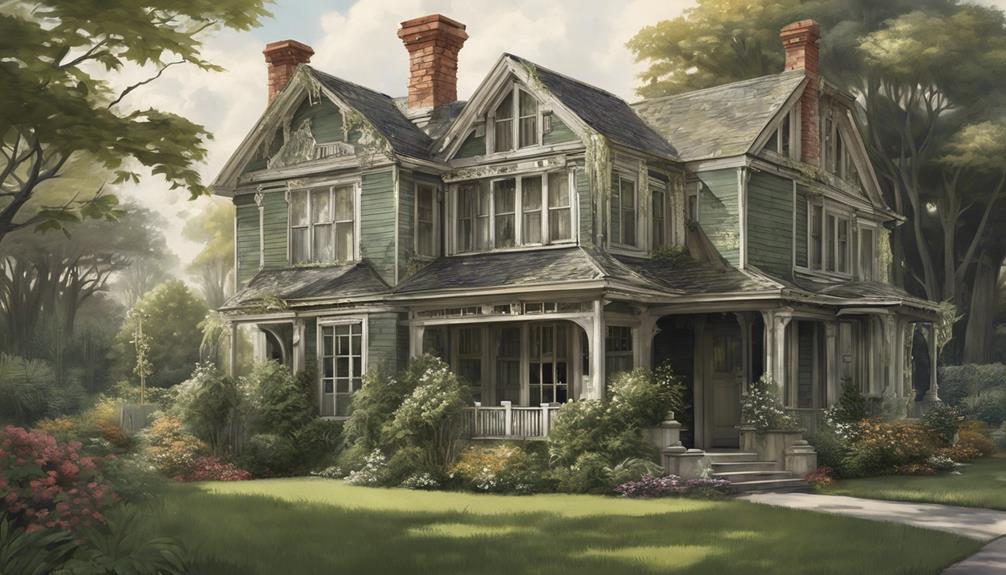
When comparing maintenance requirements, the disparities between old and modern houses become apparent.
- Old houses: Often demand more frequent maintenance due to aging infrastructure and materials, requiring vigilant upkeep to prevent deterioration.
- Modern houses: Are designed with durable and low-maintenance materials, reducing the need for constant repairs and saving time and money in the long run.
- Repairs: In old houses can be challenging and costly due to outdated systems and the scarcity of replacement parts, leading to potential delays and increased expenses.
- Modern houses: Tend to come with warranties on appliances and structural components, alleviating repair costs in the initial years and providing peace of mind to homeowners.
Considering these points, the contrast in maintenance requirements between old and modern houses underscores the importance of choosing a home that aligns with your preferences for upkeep intensity and cost-effectiveness.
Cost Disparities
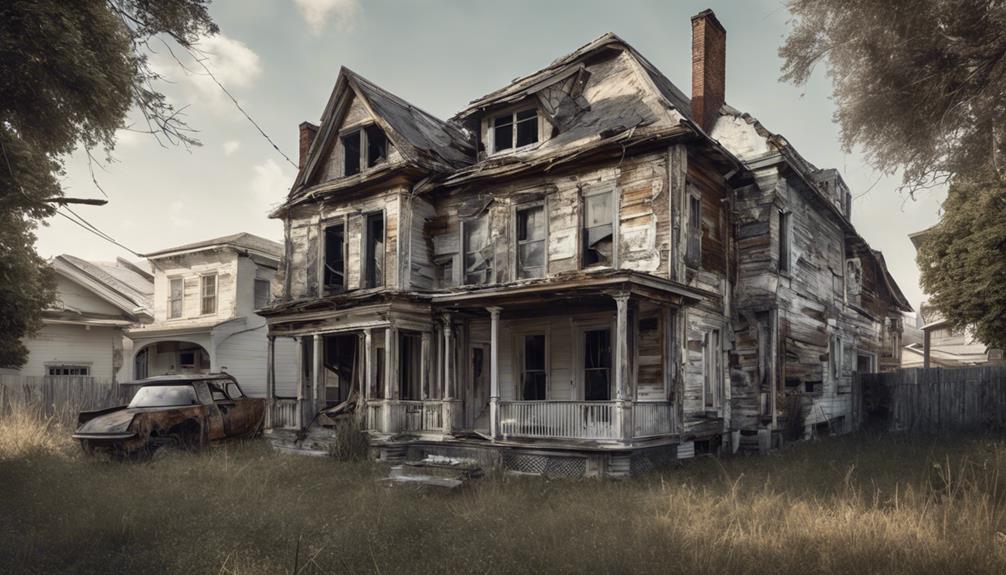
When considering the cost disparities between old and modern houses, it's crucial to analyze the budget implications and financial considerations involved.
The upfront costs of modern homes can be substantially higher due to their advanced features and energy-efficient systems, while older houses may offer a more affordable initial purchase price.
However, long-term expenses, such as maintenance and renovations, can vary significantly between the two types of properties, impacting the overall financial investment required.
Budget Implications
Exploring the budget disparities between old and modern homes reveals a significant cost variation, primarily driven by technological advancements and material upgrades in newer constructions. When considering budget implications:
- Upfront Costs: New homes often come with higher initial costs, impacting budget considerations.
- Long-Term Expenses: Old homes may require more frequent maintenance and repairs, potentially increasing overall expenses.
- Energy-Efficient Systems: Modern homes feature energy-efficient systems that contribute to higher upfront costs but can lead to savings in the long run.
- Resale Value: Understanding the financial implications of maintenance, utilities, and modern features is crucial for determining the resale value of a property.
Financial Considerations
Considering the financial disparities between old and modern houses, one key aspect to evaluate is the overall cost implications associated with these property types. New homes typically cost about 30% more than existing homes due to modern features and construction methods. While old homes may have lower upfront costs, they can incur higher maintenance expenses over time. Understanding the long-term investment potential is crucial when comparing the financial considerations of old vs. new homes. New homes often come with lower insurance costs and higher resale value, thanks to compliance with modern building codes. Additionally, energy efficiency in newer homes leads to lower utility costs, making them a more cost-effective choice in the long run.
| Financial Considerations | Old Homes | New Homes |
|---|---|---|
| Upfront Costs | Lower | Higher |
| Maintenance Expenses | Higher | Lower |
| Long-Term Investment | Requires Consideration | Potential Appreciation |
| Insurance Costs | Higher | Lower |
| Resale Value | Lower | Higher |
| Energy Efficiency | Less Efficient | More Efficient |
Environmental Impact Contrasts
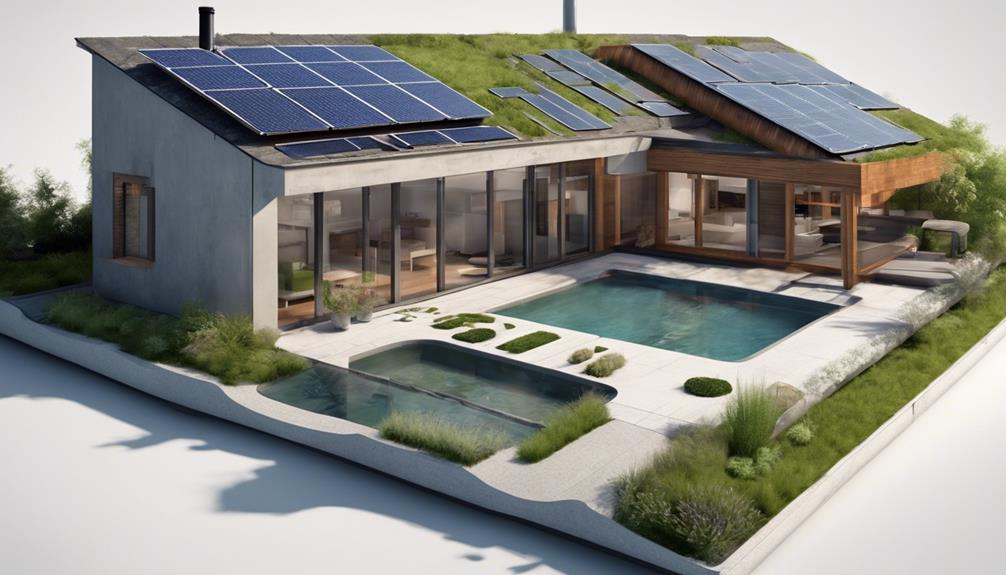
In comparing the environmental impact of old and modern houses, the use of eco-friendly materials and technologies in modern homes significantly reduces carbon footprint and energy consumption. Modern houses often incorporate sustainable practices like using recycled materials and energy-efficient systems such as smart thermostats.
On the other hand, old houses may have outdated insulation and windows, leading to higher energy consumption and increased carbon footprint. To combat this, modern homes are designed with energy-efficient appliances and windows to minimize resource usage.
Additionally, the construction of modern houses focuses on sustainability, aiming to lower environmental harm through innovative design principles. By adopting these eco-friendly measures, modern houses strive to leave a smaller ecological footprint and pave the way for a more sustainable future.
Frequently Asked Questions
What Is the Difference Between an Old House and a Modern House?
When comparing an old house to a modern house, the distinctions are striking. Old houses often boast unique charm and historic allure, while modern houses offer contemporary amenities and sleek design.
The differences extend to room layout, maintenance costs, and energy efficiency. Each type has its own appeal, with old houses showcasing character and architectural details, and modern houses prioritizing efficiency and functionality.
The evolution of housing design continues to shape our living spaces.
What Are the Two Main Differences Between the Old House and the New House?
When comparing old houses to modern ones, the primary differences lie in design and efficiency. Old houses often boast unique architectural details and historical charm, while modern homes prioritize sleek, contemporary elements.
In terms of energy efficiency, modern houses shine with better insulation and eco-friendly features, leading to reduced utility costs. These contrasting features make choosing between an old house and a modern one a matter of personal preference and lifestyle needs.
What Are the Differences Between Old Buildings and Modern Buildings?
When comparing old buildings to modern ones, we see a stark contrast in architectural styles, amenities, and safety features. Old buildings often lack modern technology and energy efficiency, while modern buildings prioritize sleek designs, eco-friendly materials, and advanced systems.
The layout of old buildings tends to be compartmentalized with smaller windows, unlike the open-concept spaces and large windows found in modern buildings. Additionally, modern buildings adhere to updated safety standards, ensuring enhanced protection for occupants.
What Is the Difference Between a Modern Mansion and a Traditional Mansion?
When comparing a modern mansion to a traditional one, the key difference lies in their design approach. Modern mansions embrace sleek lines, cutting-edge technology, and eco-friendly features, catering to a contemporary lifestyle.
In contrast, traditional mansions prioritize timeless charm, classic architectural details, and a sense of heritage. These distinctions appeal to different sensibilities and values, influencing the overall ambiance and functionality of each type of home.
Conclusion
As we delved into the differences between old and modern houses, we uncovered a fascinating truth – the evolution of architecture mirrors our changing lifestyles and values.
While old houses hold onto tradition and nostalgia, modern houses embrace innovation and efficiency.
By understanding these distinctions, we can appreciate the diverse housing options available to us, each with its unique charm and functionality.
The theory that our homes reflect our societal progression stands true, shaping our living spaces for generations to come.
- About the Author
- Latest Posts
Introducing Ron, the home decor aficionado at ByRetreat, whose passion for creating beautiful and inviting spaces is at the heart of his work. With his deep knowledge of home decor and his innate sense of style, Ron brings a wealth of expertise and a keen eye for detail to the ByRetreat team.
Ron’s love for home decor goes beyond aesthetics; he understands that our surroundings play a significant role in our overall well-being and productivity. With this in mind, Ron is dedicated to transforming remote workspaces into havens of comfort, functionality, and beauty.
Architecture Home Styles
10 Budget-Friendly Ways to Decorate Your Lake House
Create a charming lakeside oasis on a budget with these clever tips that will transform your space into a serene retreat.
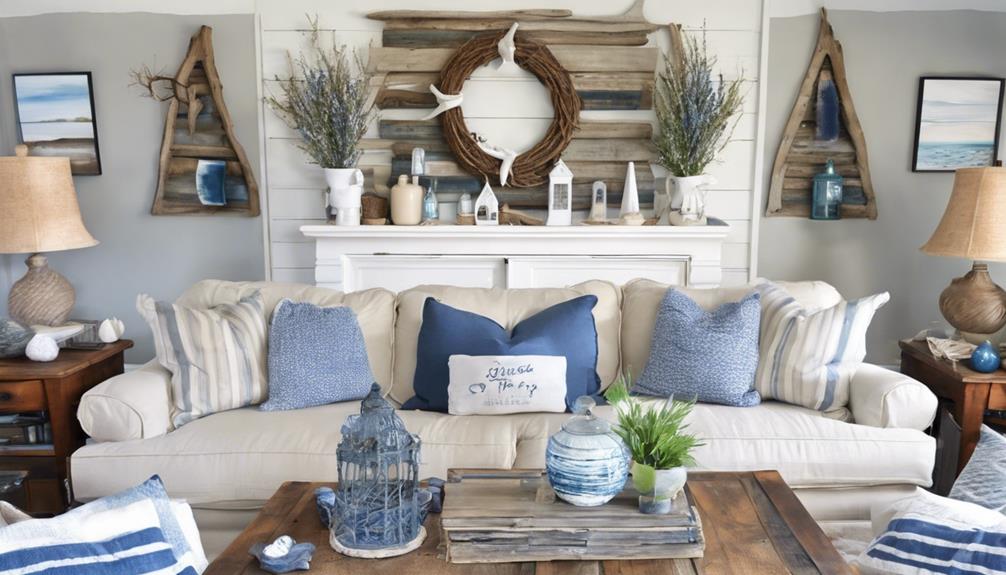
When revamping your lake house on a budget, we can revitalize the space with a fresh coat of paint and cleverly repurposed thrifted treasures. By infusing DIY charm and nature-inspired accents, we can elevate the ambiance while keeping costs in check.
From nautical rope creations to personalized touches, there are numerous cost-effective ways to transform your lake retreat into a serene haven. Let's explore how to achieve a stylish and inviting lakeside escape without overspending.
Key Takeaways
- Repaint with calming colors and incorporate natural elements for a serene lake house ambiance.
- Personalize decor with vintage finds, cozy textiles, and DIY projects for a unique touch.
- Embrace rustic charm with wood, stone, and handmade accessories in your decor.
- Add character with thrift store pieces, coastal touches, and a dynamic gallery wall for a personalized retreat.
Repaint With a Splash of Color
Revitalizing your lake house with a vibrant splash of color can breathe new life into its surroundings, creating a captivating and rejuvenating atmosphere. When choosing paint colors for your lake house, consider calming blues, refreshing greens, or soothing grays to evoke a serene lakeside ambiance. Opting for light and airy colors not only brightens up the space but also creates a relaxing atmosphere that complements the natural beauty outside. Picture walls painted in tranquil hues like pale cream, seamlessly blending with the outdoor scenery and bringing a sense of tranquility indoors.
Embracing these soothing color palettes can enhance the overall aesthetic appeal of your lake house. Imagine waking up to the gentle hues of blues and greens, feeling instantly refreshed and connected to the peaceful surroundings. With a fresh coat of paint, your lake house can transform into an oasis of relaxation and tranquility, inviting you to unwind and recharge in style. Let the colors of your lake house reflect the beauty of its surroundings, enveloping you in a soothing and revitalizing embrace.
Upcycle Thrift Store Finds
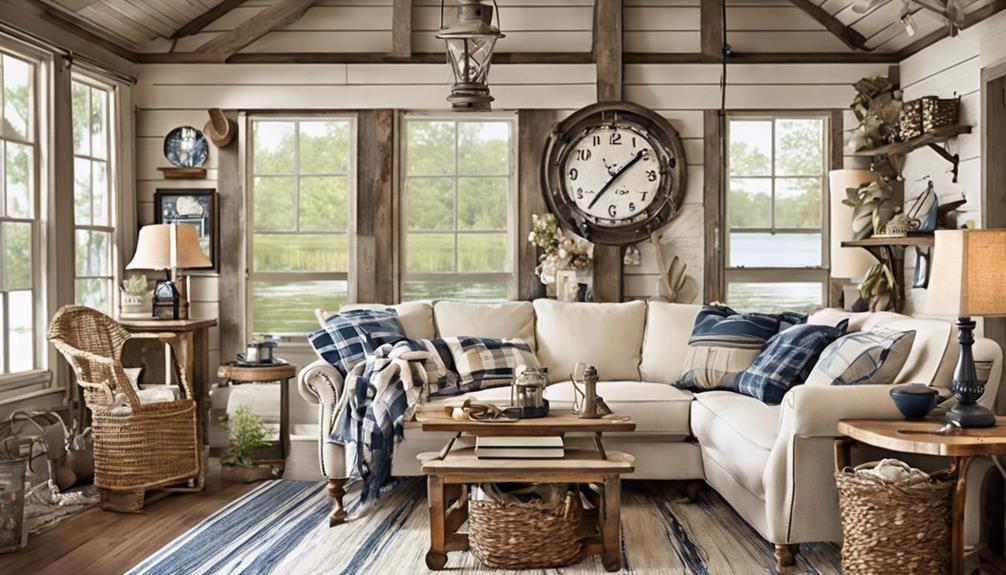
Embracing the charm of budget-friendly decor, let's now explore the art of upcycling thrift store finds to infuse your lake house with character and style. Shopping at thrift stores can unearth hidden gems that perfectly complement your design style. Here are some tips to help you make the most of your thrift store finds:
- Mix and Match: Combine wooden pieces with vintage decor items to create a cozy and inviting atmosphere in your lake house. Blend different textures and finishes for a unique look that reflects your personality.
- Handmade Touches: Look for handmade accessories like woven baskets or macramé wall hangings to add a touch of artisanal charm to your space. These one-of-a-kind pieces can serve as conversation starters and bring a sense of warmth to your home.
- Affordable Elegance: Thrift stores offer affordable treasures that can elevate your decor without breaking the bank. Embrace the thrill of the hunt and discover budget-friendly ways to enhance the style of your lake house with distinctive finds.
DIY Nautical Rope Decor
Let's get crafty with nautical rope to add a seaside vibe to our lake house!
From rope-wrapped candle holders to nautical knot coasters, the possibilities are endless.
We can create unique DIY rope wall art to personalize our space and embrace the coastal charm.
Rope-Wrapped Candle Holders
Transform your lake house into a coastal haven with charming rope-wrapped candle holders, adding a touch of nautical flair to your decor. Crafting these nautical rope-wrapped candle holders is a fun DIY project that brings a rustic ambiance to your space. Here's why you'll love them:
- Personalized Touch: Customize the size and style of the holders to perfectly fit your design preferences.
- Affordable Elegance: Enhance the nautical theme of your lake house without breaking the bank.
- Handmade Charm: Create a warm and inviting atmosphere with these handmade candle holders that exude creativity and style. Let your creativity shine as you incorporate these affordable and chic decor pieces into your lakeside retreat.
Nautical Knot Coasters
Crafting nautical knot coasters is a delightful way to infuse your lake house decor with a touch of maritime charm while also serving a practical purpose. These DIY coasters not only add a nautical touch to your space but also protect surfaces from water rings.
Using simple materials like cotton rope and hot glue, you can easily create these customizable coasters in various sizes and colors to match your decor theme. The best part is that nautical knot coasters are a budget-friendly option to add a personalized and unique element to your lake house.
Get ready to impress your guests with these charming and practical coasters that reflect your creativity and style.
DIY Rope Wall Art
Enhance your lake house decor with a touch of coastal charm through the creative and budget-friendly DIY Nautical Rope Decor. Dive into this nautical rope wall art project to infuse your space with a personalized nautical theme. Here's why you should give it a try:
- Cost-Effective: DIY rope wall art offers a pocket-friendly way to spruce up your lake house living area.
- Customizable: Get creative by incorporating knots, braids, shells, or driftwood to tailor the design to your liking.
- Ambiance Boost: This fun and easy project not only enhances the ambiance of your lake house but also adds a unique touch of coastal flair. Start crafting to transform your space today!
Bring the Outdoors in With Natural Elements

Bringing the outdoors inside our lake house, we integrate natural elements like wood, stone, and plants to infuse a touch of nature into our decor. To achieve a cozy, rustic vibe, we place pine cones in wicker baskets and use wood scrap picture frames. Wood signs with engraved names add warmth and character to the space, while fabrics that complement wooden features create a homely feel. Accessories such as driftwood, rocks, and leaves further enhance the natural ambiance of our lake house decor, bringing a breath of fresh air indoors.
Create a Gallery Wall of Lake-Inspired Art

Let's curate a stunning gallery wall with lake-inspired artwork to infuse our space with charm and personality.
We can mix and match frame styles, incorporating DIY pieces for a unique twist.
Art Selection Tips
Crafting a captivating gallery wall of lake-inspired art infuses a space with charm and personality, bringing the serene beauty of the lakeside indoors. When selecting artwork for your gallery wall, consider the following tips:
- Diverse Subjects: Choose a mix of lake scenes, boats, wildlife, and nature to create a dynamic visual narrative.
- Varied Sizes and Frames: Mix and match different sizes and frames to add depth and visual interest to your gallery wall.
- DIY Elements: Incorporate DIY art projects using lake elements like driftwood, rocks, and shells to infuse a personalized touch and showcase your creativity.
Layout and Arrangement
To curate a captivating gallery wall of lake-inspired art, we blend a mix of photography, paintings, and prints that encapsulate the essence of lakeside living, incorporating frames of various sizes and styles for added visual intrigue and depth. By including personal photos or artwork, we transform the space into a personalized sanctuary that speaks to our individual connection with the lake house interior. To ensure a cohesive arrangement, we strategically place each piece to create a stunning focal point in the room, drawing the eye to the beauty of the lake-inspired art collection. This gallery wall not only adds visual interest but also infuses the space with a sense of creativity and personal touch.
| Left Column | Right Column |
|---|---|
| Photography | Various Frames |
| Paintings | Personalized Artwork |
| Prints | Different Sizes |
| Lakeside Living | Visual Intrigue |
| Personal Photos | Cohesive Arrangement |
DIY Framing Ideas
In our quest to craft a captivating gallery wall of lake-inspired art, we delve into innovative DIY framing ideas to infuse our space with a personalized touch that resonates with the essence of lakeside living. Here are three ways to create a stunning display:
- Natural Elements: Incorporate driftwood frames for a rustic and organic feel.
- Mix and Match: Experiment with different frame styles and sizes to create an eclectic and visually interesting gallery wall.
- Vintage Maps: Showcase vintage lake maps or nautical charts in unique frames for a charming and nostalgic touch.
With these creative approaches, your gallery wall won't only reflect your love for the lake but also add a stylish and personalized element to your home decor.
Refresh Furniture With Slipcovers or Paint

With slipcovers or a fresh coat of paint, your lake house furniture can undergo a stunning transformation that won't break the bank. Slipcovers are an affordable way to refresh outdated furniture, offering a quick solution to breathe new life into your pieces. They come in various colors and patterns, allowing you to choose options that complement your desired style and lake house decor. Additionally, slipcovers provide protection against wear and tear, ultimately extending the lifespan of your furniture. On the other hand, painting your furniture can also work wonders in transforming its look without the need to invest in new pieces. Select paint colors that harmonize with the overall aesthetic of your lake house for a cohesive and stylish feel. By incorporating slipcovers or a fresh coat of paint, you can revamp your furniture to align with the ambiance of your lake house while staying within budget.
| Slipcovers | Benefits |
|---|---|
| Affordable | Refresh outdated furniture |
| Various colors and patterns | Protects furniture |
| Complements style | Extends furniture lifespan |
| Painting | Benefits |
| Transforms furniture | Cost-effective update |
| Complements decor | Creates cohesive look |
Incorporate Cozy Textiles and Throw Pillows
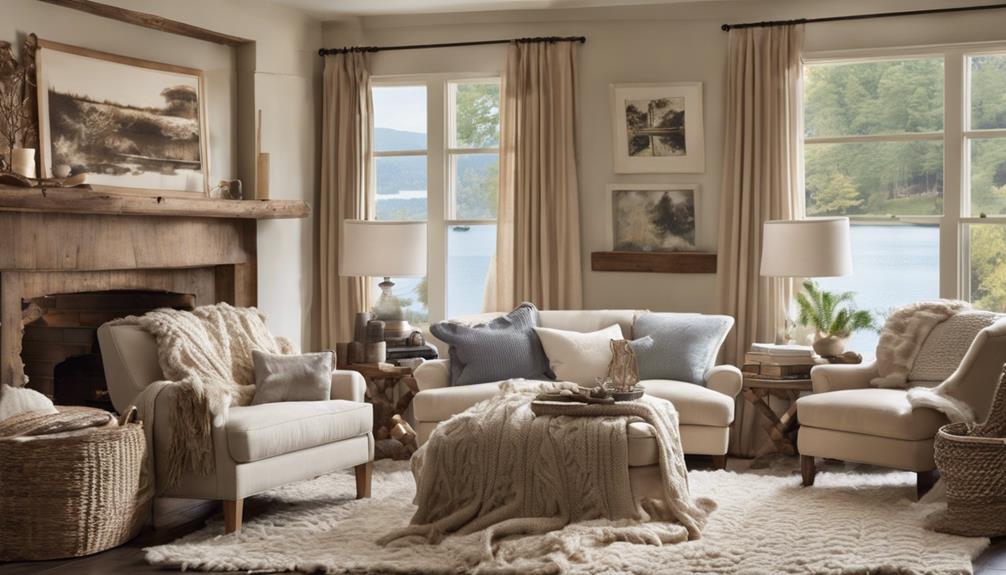
Let's talk about how to elevate your lake house decor with cozy textiles and throw pillows. By carefully selecting different textures and patterns, you can effortlessly add warmth and style to your living spaces.
We'll also explore creative ways to arrange throw pillows to bring color and comfort to your seating areas.
Textile Selection Tips
Snuggling up with plush blankets and adding a touch of color with throw pillows can transform your lake house into a cozy retreat. When selecting textiles for your space, consider the following:
- Mix Textures: Combine different fabrics like cotton, wool, and faux fur to create a layered and inviting atmosphere.
- Colorful Throw Pillows: Opt for throw pillows in various hues, patterns, and textures to infuse vibrancy and comfort into your seating areas.
- Lake-Inspired Designs: Choose decorative pillows with lake-themed motifs such as fish, boats, or nautical stripes to amplify the lakeside ambiance in your home.
Pillow Arrangement Ideas
Cocooned in a symphony of cozy textiles and plush throw pillows, our lake house exudes warmth and charm.
To create a visually appealing pillow arrangement, mix and match different sizes, shapes, and textures of throw pillows. Incorporate cozy textiles like faux fur and knits for added comfort.
Add a touch of flair by choosing throw pillows with patterns such as stripes, florals, or geometric designs to introduce pops of color into your decor. Enhance the overall aesthetic by layering throw pillows in complementary colors and patterns.
For a seasonal twist, consider switching to throw pillows with seasonal themes or holiday motifs to keep your lake house decor fresh and exciting throughout the year.
Utilize Vintage and Antique Finds
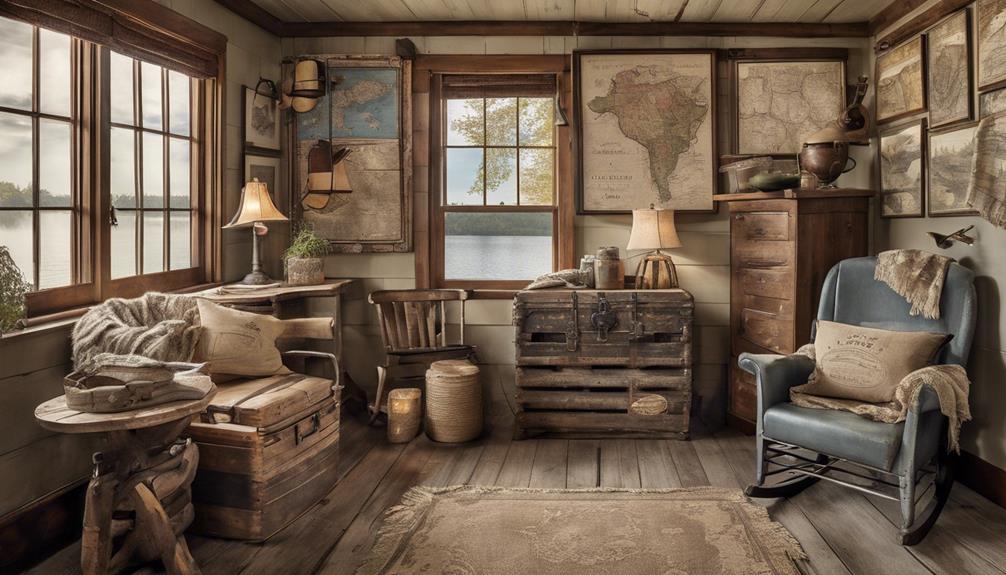
Enhancing your lake house decor with vintage and antique finds infuses a touch of history and character into your living space. Shopping for second-hand items not only saves you money but also helps create a unique look that sets your home apart.
Incorporating vintage pieces can give your space a rustic-chic or eclectic vibe, adding a sense of warmth and personality. Antique furniture and accessories bring a deep sense of history and nostalgia to your home, telling stories of eras gone by.
Mixing vintage finds with modern elements can result in a stylish and personalized interior design that showcases your creativity and eye for design. By carefully selecting and integrating these vintage and antique treasures, you can transform your lake house into a cozy retreat filled with charm and individuality.
Enhance Lighting With Affordable Fixtures

Let's illuminate your lake house with character and charm by incorporating affordable vintage lighting fixtures. Vintage lighting pieces not only add a touch of character but can also be found at budget-friendly prices, making them a perfect choice for enhancing your space without breaking the bank. Consider updating hardware on your current fixtures to give them a stylish look and create a cohesive design theme throughout your home. For a cozy ambiance, opt for dramatic lighting enhancements like dimmable lights or statement chandeliers that can elevate the overall atmosphere of your lake house.
When looking for affordable fixtures, explore thrift stores, online marketplaces, or garage sales to discover hidden gems that can bring a unique flair to your decor. Additionally, adding indoor plants can complement your lighting choices by bringing life and natural elements into your space, without the need for expensive lighting upgrades. By combining vintage lighting fixtures, updating hardware, and incorporating indoor plants, you can achieve a stylish look that reflects your personal taste while staying within your budget.
Personalize With DIY Signs and Decorations

To infuse a personalized and creative touch into your lake house decor, consider crafting DIY signs and decorations using reclaimed materials and natural elements.
DIY signs made from reclaimed wood not only add a rustic charm but also reflect your individual style. Design unique decorations by incorporating pressed flowers and other natural elements for a custom look that brings the beauty of the outdoors inside.
Personalize your space further by creating custom artwork that speaks to your personality and interests, adding a touch of uniqueness to every corner. Additionally, repurpose old window frames as decor pieces to infuse character and charm into your lake house aesthetic.
Embrace your creativity with hand-painted signs that showcase your artistic flair and make a statement. With these personalized DIY touches, your lake house will truly feel like a reflection of your style and creativity.
Frequently Asked Questions
How Do You Tastefully Decorate a Lake House?
When decorating a lake house, we aim for a tasteful blend of natural elements and soothing colors that complement the tranquil surroundings. By incorporating wood, stone, and plants, we create a cohesive decor theme that reflects the beauty of the lake.
Our minimalist approach allows the stunning views to take center stage, while personal touches like artwork add warmth and character to the space.
How to Decorate a Lakeside Cabin?
When decorating a lakeside cabin, we aim for a look that blends nature with comfort. Our approach involves using natural elements like wood and stone, along with a color scheme inspired by the serene lake surroundings.
How Can I Spruce up My House on a Budget?
We can spruce up our house on a budget by getting creative with simple yet impactful changes.
Let's start by refreshing the space with a new coat of paint in light, neutral tones for a fresh and airy vibe.
Next, we can scout for preloved furniture pieces and haggle for great deals.
Engaging in DIY projects like reupholstering and staining can add a personalized touch without breaking the bank.
Let's infuse unique artistic elements for character and charm.
How Do I Make My House Feel Like a Lake House?
When we make our house feel like a lake house, we focus on natural elements, calming colors, and nautical decor.
By incorporating wood, stone, and plants, choosing a color palette inspired by the lake, and adding nautical items like ropes and anchors, we create a relaxing and inviting ambiance.
Comfortable furniture and personal touches like artwork and photos help us infuse our love for the lake into every corner of our home.
Conclusion
In conclusion, embrace the beauty of budget-friendly decorating at your lake house! Get creative with color, upcycle unique finds, and bring the outdoors in with natural elements.
Remember to incorporate cozy textiles, vintage treasures, and personalized touches to make your space truly shine. With these tips, you can transform your lake house into a stylish sanctuary without spending a fortune.
Don't hesitate to dive into decorating with flair and finesse!
- About the Author
- Latest Posts
Introducing Ron, the home decor aficionado at ByRetreat, whose passion for creating beautiful and inviting spaces is at the heart of his work. With his deep knowledge of home decor and his innate sense of style, Ron brings a wealth of expertise and a keen eye for detail to the ByRetreat team.
Ron’s love for home decor goes beyond aesthetics; he understands that our surroundings play a significant role in our overall well-being and productivity. With this in mind, Ron is dedicated to transforming remote workspaces into havens of comfort, functionality, and beauty.
Architecture Home Styles
How Do You Make a Modern Mountain Interior Shine?
Breathe life into your modern mountain interior with personalized touches that add charm and character – discover the secret to making your space truly unforgettable.
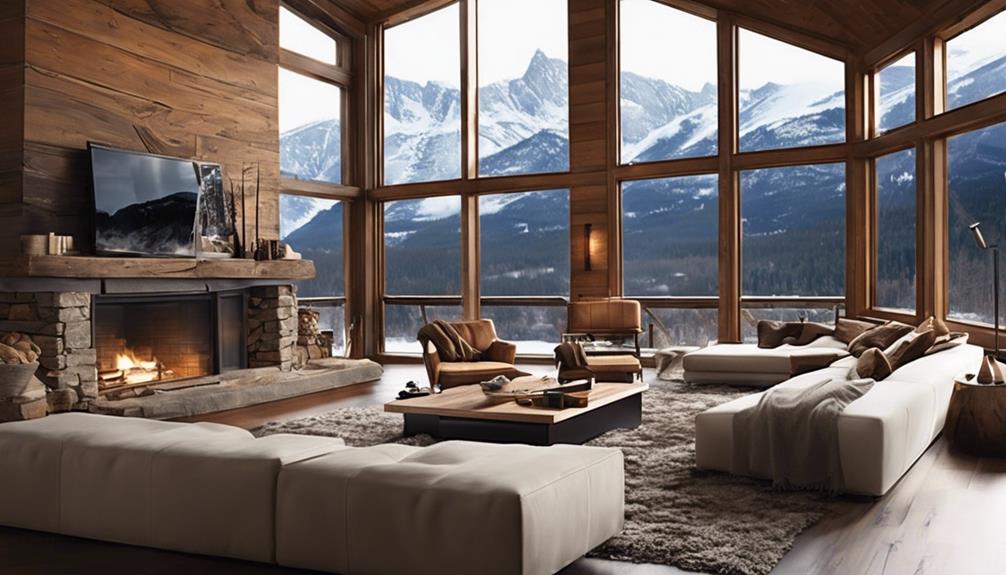
When it comes to making a modern mountain interior truly stand out, we've found that the key lies in striking the perfect balance between nature-inspired elements and contemporary design.
But there's one crucial aspect that often gets overlooked in this quest for perfection – the art of incorporating personal touches that infuse character and uniqueness into the space.
Curious to discover how these individualistic details can elevate your mountain retreat to new heights of style and sophistication?
Key Takeaways
- Blend natural elements with modern design for a mountain essence.
- Incorporate statement pieces like bold lighting and artwork for impact.
- Choose a nature-inspired color palette with pops of color for visual interest.
- Balance rustic textures with sleek finishes to achieve a modern yet cozy ambiance.
Highlighting Natural Beauty Through Contrast
Embracing the essence of the mountains, we intertwine modern elements with the raw beauty of nature to create a harmonious contrast that captivates the soul. In our pursuit of mountain modern design, we utilize a neutral color palette to set the stage for this exquisite blend. Natural textures like wood and stone are carefully selected to highlight the rugged yet elegant features of the surroundings. Large windows act as portals to the breathtaking mountain views, forging a seamless connection between the interior and exterior spaces.
To enhance the modern mountain interior design, we balance sleek, minimalist furniture with organic textures, creating a sense of warmth and comfort. The incorporation of metal accents and rustic materials adds depth and character to the space, underscoring the contrast between the modern and the natural. This fusion of elements not only celebrates the beauty of the mountains but also elevates the overall aesthetic, appealing to those who seek innovation in design.
Incorporating Sleek Design Elements
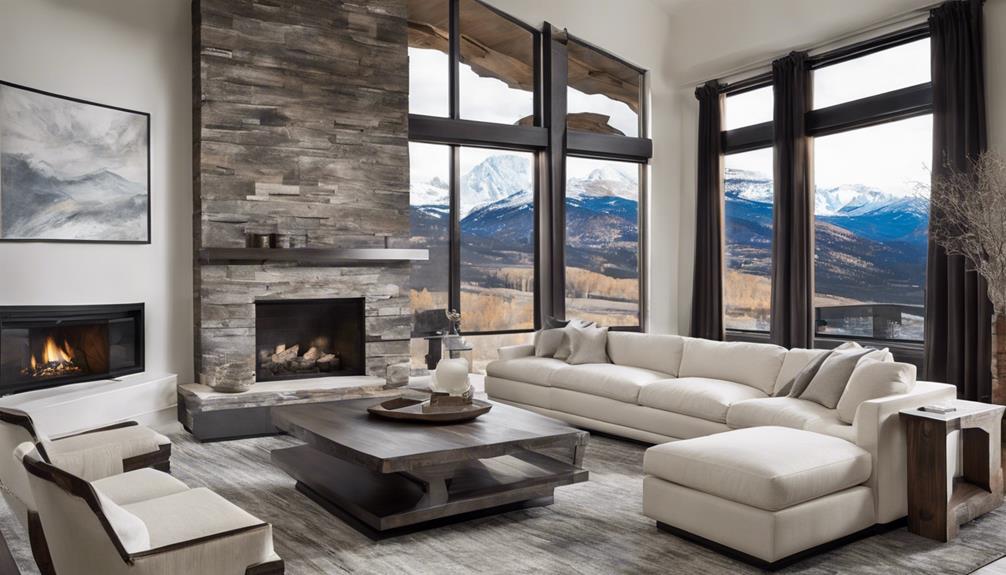
As we continue to craft the modern mountain interior, the infusion of sleek design elements elevates the space with a contemporary allure. To achieve a harmonious blend of modernity and mountain charm, incorporating specific elements is essential:
- Minimalist Furniture: Opt for sleek, simple furniture pieces with clean lines to maintain a clutter-free aesthetic while maximizing space within the mountain interior.
- Metal Accents: Introduce black steel elements strategically to add a touch of industrial chic to the design, creating a striking contrast against the natural mountain backdrop.
- Modern Lighting Fixtures: Select contemporary lighting fixtures that not only illuminate the space but also serve as stylish focal points, enhancing the overall modern ambiance.
- Simple Finishes: Choose understated finishes that complement the rugged textures of the mountain environment, balancing sophistication with the raw beauty of nature.
Elevating With Statement Pieces
Elevate your modern mountain interior with captivating statement pieces that command attention and infuse personality into the space. To achieve a Mountain Modern Interior Design that truly shines, consider incorporating striking chandeliers or pendant lights as focal points, illuminating the room with a touch of elegance.
Introduce a large, eye-catching piece of artwork or a unique sculpture to add depth and character, creating a visual masterpiece that captures the essence of modern living. Opt for a bold, statement rug with intricate patterns or vibrant colors to anchor the room and make a lasting impression on guests.
Selecting unique accessories and architectural features, such as a signature piece of furniture or a dramatic fireplace design, will further enhance the space's aesthetic appeal. Embrace the power of statement pieces to transform your interior into a showcase of contemporary style and sophistication, where every corner tells a story and every detail reflects your individuality.
Choosing the Right Color Palette
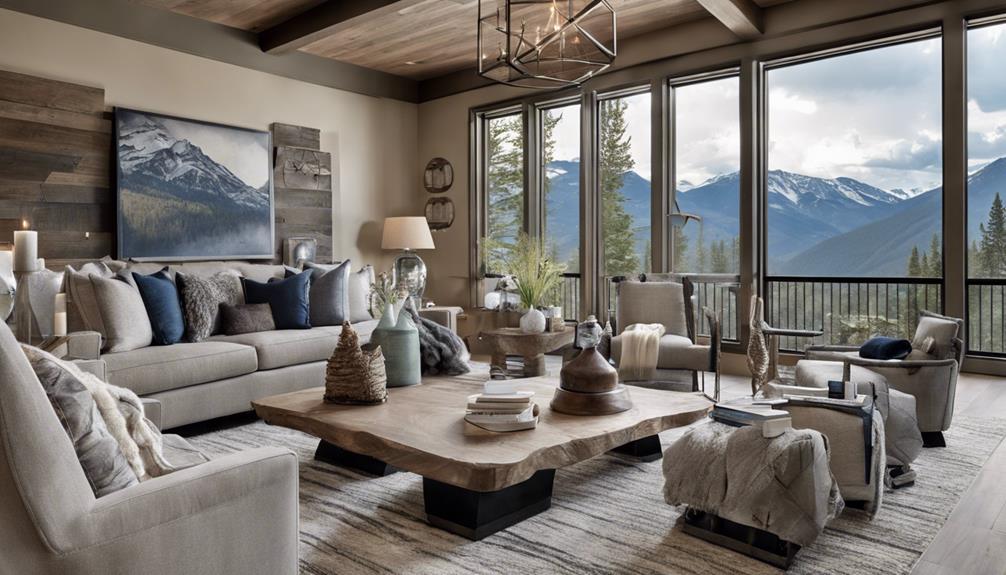
Immerse your modern mountain interior in a color palette inspired by the serene hues of nature, such as warm browns, soothing greens, and calming blues. To achieve a modern mountain interior that truly shines, consider the following:
- Incorporate pops of color: Add visual interest and warmth by introducing accents of rusty reds or deep oranges to your color scheme.
- Opt for neutral tones: Establish a versatile base with neutral tones that offer a backdrop for accent colors to shine through decor and accessories.
- Create a cohesive look: Maintain a consistent color scheme throughout the space to tie together various elements seamlessly and achieve a harmonious overall aesthetic.
- Experiment with shades and tones: Play with different depths and variations within the chosen color palette to introduce depth and dimension into your modern mountain interior design.
Balancing Rustic Charm With Modern Flair
How can we seamlessly blend rustic charm with modern flair to create a captivating mountain interior design that exudes warmth and sophistication? In crafting a modern mountain home, the key lies in the artful fusion of rustic elements with contemporary touches. By incorporating natural materials such as wood and stone alongside clean lines and minimal ornamentation, we strike a balance that elevates the space. To achieve this harmonious blend, consider the following approach:
| Incorporate Rustic Textures | Merge with Contemporary Elements | Play with Earthy Tones |
|---|---|---|
| Introduce warmth through rustic textures like reclaimed wood or stone. | Pair these textures with sleek, modern finishes for a sophisticated look. | Layer warm, earthy tones with neutral colors for a cozy yet refined ambiance. |
Frequently Asked Questions
How Do You Make a Mountain Modern Interior?
We make a mountain modern interior by blending natural textures like wood, metal, and stone. Authentic rustic materials infuse history and soul, balancing modern finishes with rugged details.
We prioritize natural and accent lighting to create warmth and embrace windows as art to connect with the outdoors. Cozy textiles, inviting furniture, and thoughtful lighting choices infuse warmth, creating a welcoming ambiance in a mountain modern interior.
What Is Mountain Interior Design Style Called?
We call the design style for mountain interiors 'Mountain Modern.' It blends rustic charm with contemporary flair, focusing on natural elements like wood and stone in sleek, minimalist designs.
Neutral colors, abundant natural light, and a seamless indoor-outdoor flow characterize this style. The aim is to evoke authenticity, warmth, and a strong connection to the mountain landscape.
Open-concept spaces, gable roofs, and a mix of textures such as fur and leather are common in Mountain Modern homes.
What Is Modern Mountain Style?
Modern mountain style is a fusion of rustic charm and contemporary flair, blending natural elements like wood and stone with clean lines and neutral tones. It creates a cozy yet sophisticated ambiance, highlighting spacious layouts and seamless indoor-outdoor connections.
How Can I Make My Interior Look More Modern?
To make our interior look more modern, we focus on clean lines, neutral tones, and sleek finishes. We incorporate black steel elements and natural materials like wood and stone for a sophisticated touch.
Quality craftsmanship in simple, functional furniture pieces enhances the contemporary vibe. Strategic lighting and cozy textiles create a welcoming atmosphere.
Our space exudes modernity with a minimalist approach and a focus on high-quality design elements.
Conclusion
As we bring together the elements of nature and modern design in a mountain interior, we create a harmonious blend of tradition and innovation.
By embracing the beauty of contrasting textures and colors, we invite a sense of balance and serenity into our space.
Let's continue to shine bright, illuminating the path towards a sanctuary of peace and tranquility in our modern mountain retreat.
- About the Author
- Latest Posts
Introducing Ron, the home decor aficionado at ByRetreat, whose passion for creating beautiful and inviting spaces is at the heart of his work. With his deep knowledge of home decor and his innate sense of style, Ron brings a wealth of expertise and a keen eye for detail to the ByRetreat team.
Ron’s love for home decor goes beyond aesthetics; he understands that our surroundings play a significant role in our overall well-being and productivity. With this in mind, Ron is dedicated to transforming remote workspaces into havens of comfort, functionality, and beauty.
Architecture Home Styles
10 Real Brutalist Houses in Iceland You Need to See
Discover the hidden stories and innovative designs of 10 real brutalist houses in Iceland, each waiting to reveal their secrets.
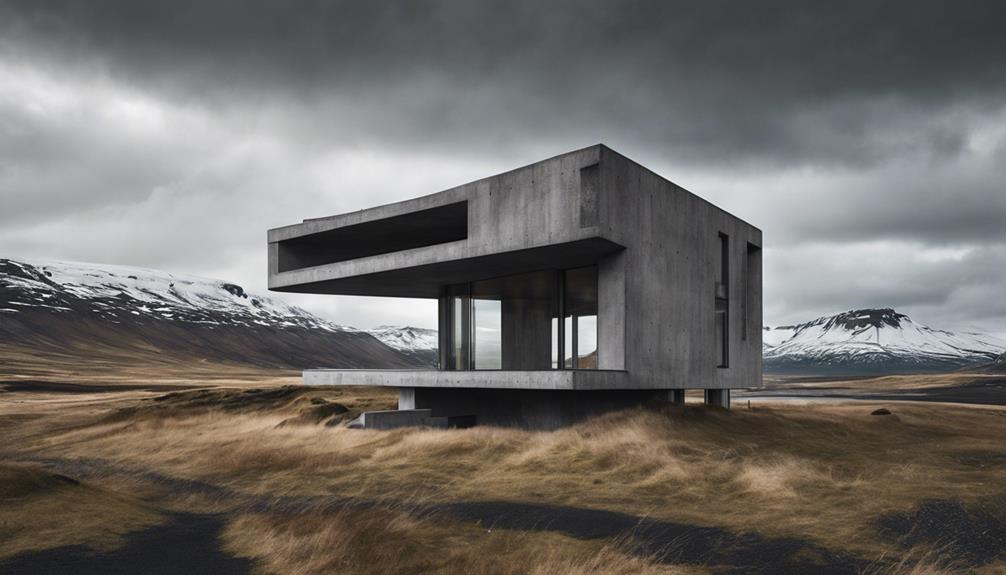
As we journey through the rugged Icelandic landscapes, the stark beauty of 10 real brutalist houses emerges like monumental sculptures against the raw elements.
Each structure, from the enigmatic Harpa Concert Hall to the futuristic University of Iceland – Main Building, beckons with a story waiting to be uncovered.
With innovative designs and historical significance, these architectural gems offer a glimpse into Iceland's architectural evolution.
Join us as we unravel the secrets behind these concrete behemoths and discover why they are essential stops on any architectural exploration of Iceland.
Key Takeaways
- Reykjavík boasts iconic brutalist landmarks like Hallgrímskirkja Church and University of Iceland, showcasing unique architectural styles.
- Cultural and artistic spaces like Reykjavik Art Museum and Kjarvalsstaðir Art Museum exhibit innovative design transformations in Iceland.
- Modern architectural gems such as Reykjavik City Hall and Hotel Borg reflect a blend of historic and contemporary influences in Reykjavík.
- The transformation of The Pearl from hot water storage tanks to a cultural gem highlights innovative design approaches in Iceland.
Harpa Concert Hall
Located in Reykjavík, Iceland, the Harpa Concert Hall stands as a modern landmark that captivates visitors with its distinctive glass facade inspired by Icelandic nature and light. Designed by Henning Larsen Architects in collaboration with Olafur Eliasson, this architectural marvel seamlessly blends contemporary design with Iceland's unique essence. The interplay of light and the surrounding environment is masterfully captured through the intricate geometric patterns of the glass panels, creating a mesmerizing visual experience for all who encounter it.
Not only does the Harpa Concert Hall serve as a venue for cultural events, concerts, and conferences, but it also represents a shining example of architectural innovation. Its ability to harmonize with the natural beauty of Iceland while exuding a sense of modernity has earned it the prestigious Mies van der Rohe Award in 2013. This recognition further solidifies the Harpa Concert Hall's status as a groundbreaking architectural gem in Reykjavík, inviting visitors to immerse themselves in a space where art, nature, and design converge in perfect harmony.
Hallgrímskirkja Church
The transition from the modernist allure of the Harpa Concert Hall to the iconic presence of Hallgrímskirkja Church in Reykjavík, Iceland, showcases a shift from contemporary glass facades to a towering architectural marvel inspired by Iceland's natural landscape and volcanic formations. Designed by architect Guðjón Samúelsson, this impressive structure took over four decades to complete, standing tall at 74.5 meters.
Here are some key features of Hallgrímskirkja Church:
- The ground floor of the church is adorned with intricate details reflecting the brutalism concept.
- Unlike the glass-dominated Harpa Concert Hall, Hallgrímskirkja's exterior is a tribute to the Icelandic landscape, specifically basalt lava flows.
- Visitors can ride an elevator to the top of the church, offering a breathtaking panoramic view of Reykjavík and its surroundings.
- Guðjón Samúelsson's architectural prowess shines through in the church's unique design, making it a standout landmark in Iceland.
- The fusion of brutalist elements with inspiration drawn from the Icelandic terrain gives Hallgrímskirkja its distinctive and awe-inspiring appeal.
The Pearl (Perlan)
Perched atop Öskjuhlíð hill, The Pearl (Perlan) in Reykjavík, Iceland, stands as a multifaceted architectural marvel blending functionality with panoramic grandeur. Originally designed as hot water storage tanks, this Brutalist House in Iceland was transformed into a cultural gem by the LYX arkitekter company. The brutalism concept created here is undeniable, with the glass dome offering panoramic views of Reykjavík and the surrounding areas, making it a must-see for architecture enthusiasts.
One of The Pearl's most striking features is the spectacular panoramic pool housed within its structure. The seamless integration of the pool with the surrounding landscape showcases the innovative design approach taken by the architects. Additionally, the fascinating master bedroom within The Pearl provides a unique living experience, combining comfort with unparalleled views.
The ground floor contains living spaces that seamlessly connect with the outdoors, emphasizing a harmonious relationship between the interior and exterior environments. The use of panoramic glass guarantees a constant connection to the breathtaking surroundings, making The Pearl a true architectural marvel in Iceland.
National Theatre of Iceland
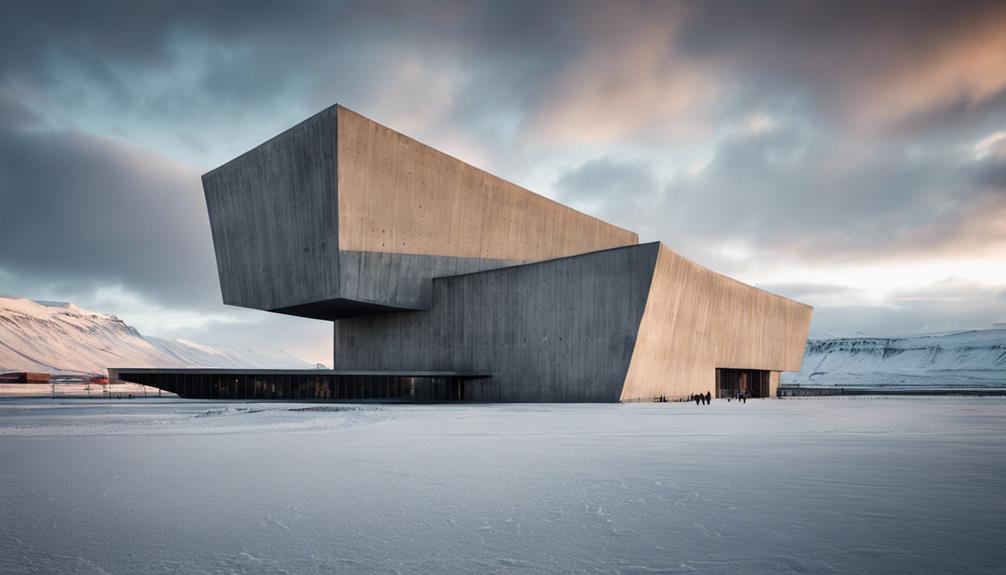
The National Theatre of Iceland, designed by architects Gudjón Samúelsson, captivates with its unique brutalist architecture, making it a standout cultural landmark in Reykjavik.
The impact of this architectural gem on the community is palpable, drawing in locals and tourists alike to experience a variety of performances, from plays to operas and concerts.
Its presence not only enriches the cultural fabric of Iceland but also serves as a testament to the enduring power of innovative design in shaping communal spaces.
Unique Architectural Design
Amidst the architectural landscape of Reykjavík stands the National Theatre of Iceland, a striking testament to the fusion of brutalist aesthetics and cultural significance. Designed by the renowned Guðjón Samúelsson, this architectural marvel showcases the bold characteristics of brutalist architecture with its imposing concrete facades.
The unique design of the National Theatre not only serves as a cultural landmark but also as a hub for performing arts and cultural events in Iceland. Its architectural style reflects a deep connection to the cultural identity of the nation, making it a standout example of innovative design that seamlessly integrates with its surroundings.
- Bold Brutalist Aesthetics
- Imposing Concrete Facades
- Reflection of Cultural Identity
- Hub for Performing Arts
- Integration with Surroundings
Cultural Significance
With its roots firmly embedded in Icelandic culture, the National Theatre of Iceland stands as a beacon of artistic expression and cultural heritage in Reykjavík. Founded in 1950, this cultural landmark plays a vital role in promoting and preserving Icelandic arts.
The theatre's architectural design, influenced by modernist styles intertwined with Icelandic cultural elements, sets it apart as a unique and significant institution. By showcasing a diverse range of performances, from traditional Icelandic plays to contemporary and international productions, the National Theatre of Iceland not only entertains but also educates and inspires audiences.
Its commitment to preserving and promoting Icelandic performing arts makes it a cornerstone of cultural enrichment in Reykjavík.
Impact on Community
An integral component of Reykjavík's cultural fabric, the National Theatre of Iceland embodies a dynamic fusion of artistic expression and community engagement. The theatre stands as a cultural landmark, bridging the gap between the architectural field and the performing arts.
Its impact on the community can be seen through its diverse programming, including traditional Icelandic plays and contemporary performances, enriching the city's rich cultural heritage. Renowned actors, directors, and playwrights who've graced its stage have elevated the theatre's reputation, making it a hub for creativity and innovation.
The National Theatre of Iceland serves as a beacon of artistic excellence, fostering a sense of community pride and unity through its immersive and thought-provoking productions.
University of Iceland – Main Building
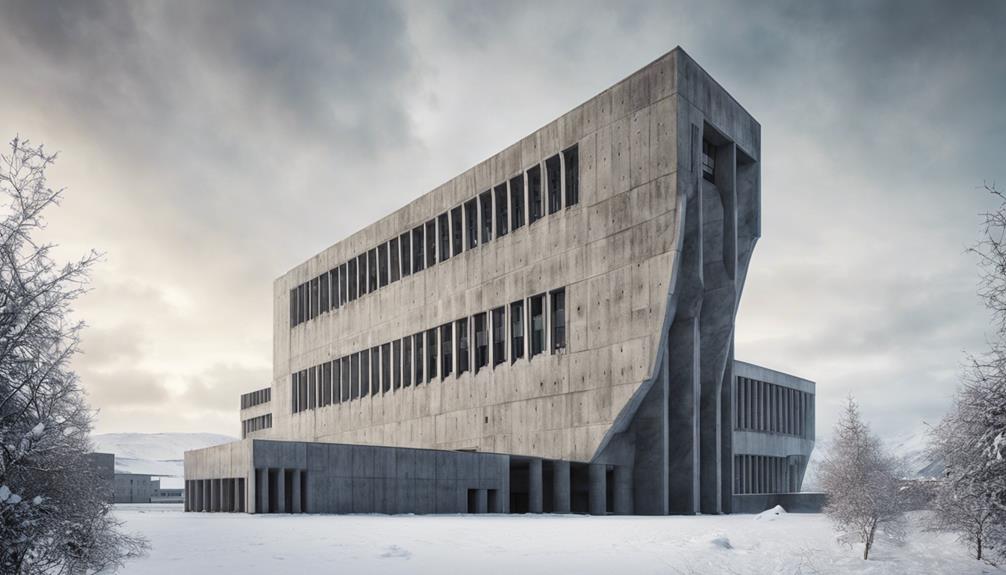
Standing proudly in the heart of Reykjavík, the University of Iceland's Main Building exemplifies the raw power and artistic vision of brutalist architecture with its striking concrete design. Designed by Hannes Krage and inaugurated in 1981, this architectural gem is a prime example of brutalist principles, showcasing the bold and unapologetic use of concrete construction. The Main Building's geometric design, characterized by sharp angles and textured surfaces, creates a visually captivating experience for visitors.
Beyond its aesthetic appeal, the Main Building serves as a functional space, housing a variety of university departments and administrative offices. Its significance extends beyond mere utility, as it stands as a prominent cultural and architectural landmark in Reykjavík, contributing to the city's unique skyline and heritage. The building's imposing presence commands attention and sparks contemplation about the intersection of art, education, and urban design.
For enthusiasts of innovative architecture, the University of Iceland's Main Building is a must-see destination that embodies the spirit of brutalism in a modern context.
Reykjavik Art Museum – Hafnarhus
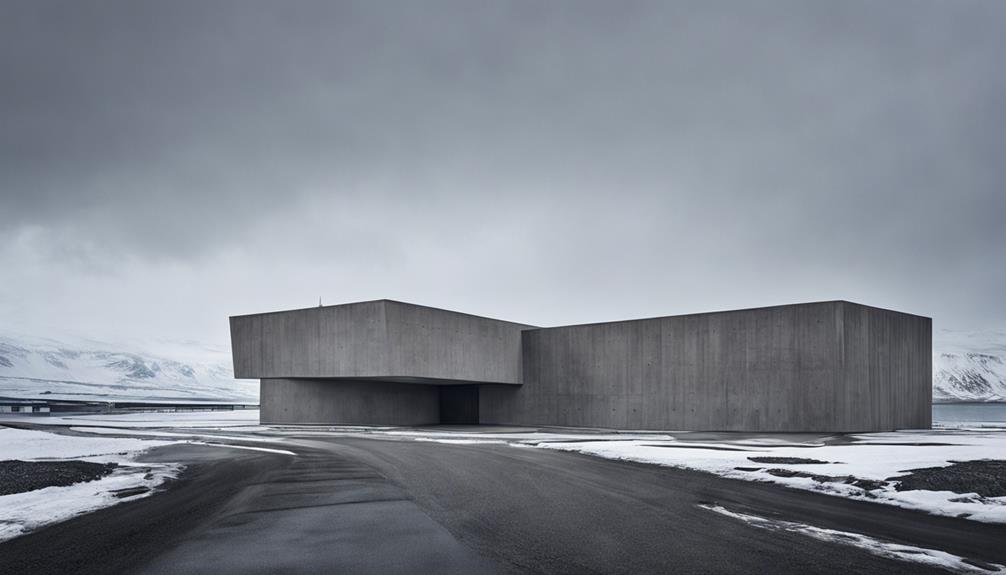
Located in the vibrant city of Reykjavik, Hafnarhus, a branch of the Reykjavik Art Museum, offers a captivating exploration of contemporary art within a former fish factory setting. The museum's artistic displays are enhanced by the industrial design of the space, creating a unique atmosphere for visitors to immerse themselves in the world of modern art.
Here are some key highlights that make Hafnarhus a must-visit destination in Reykjavik:
- Innovative Design: The transformation of a fish factory into an art museum is a testament to creative architectural repurposing.
- Panoramic Views: The museum's location provides visitors with stunning views of Reykjavik, adding an extra dimension to the art experience.
- Container of Creativity: Hafnarhus acts as a container for artistic expression, housing a diverse range of sculptures, paintings, and multimedia installations.
- Cultural Pool: Dive into the rich cultural pool of Reykjavik at Hafnarhus, where contemporary art thrives in a dynamic environment.
- Artistic Vision: The museum's curation reflects a forward-thinking artistic vision, pushing boundaries and inspiring innovation in visitors.
Landakotskirkja (Cathedral of Christ the King)
The transition from exploring the innovative design of Reykjavik Art Museum – Hafnarhus to discussing Landakotskirkja (Cathedral of Christ the King) in Reykjavík reveals a stark contrast in architectural styles. While the former embraces industrial repurposing, the latter showcases the bold geometric forms of brutalism. Designed by architect Guðjón Samúelsson, Landakotskirkja stands as a notable example of brutalist architecture in Iceland. The cathedral's use of concrete elements and its focus on bold geometric shapes contribute to its iconic status in Reykjavík's architectural heritage.
Landakotskirkja's imposing presence and distinctive brutalist characteristics make it a standout landmark in the city. The way it merges the rawness of concrete with intricate geometric details is a testament to the innovative approach of Guðjón Samúelsson. For enthusiasts of architectural innovation, exploring Landakotskirkja offers a glimpse into the power of brutalism to shape a cityscape and leave a lasting impression on its visitors.
Reykjavik City Hall
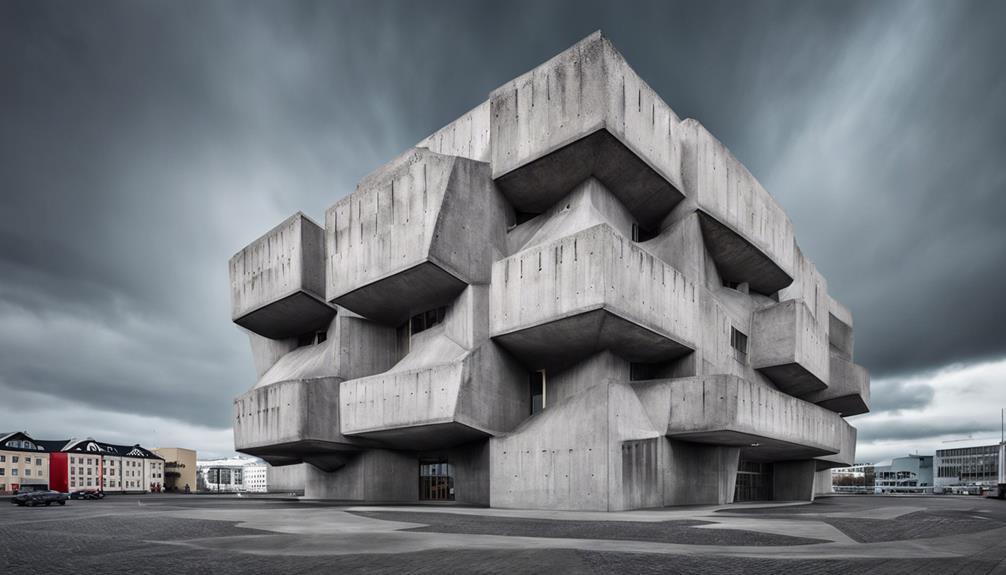
Reykjavik City Hall, a modernist architectural gem nestled by the serene Tjörnin lake in the heart of Reykjavik, captivates with its sleek glass façade and striking geometric design elements. Designed by Studio Granda, this building stands out as a prime example of contemporary urban architecture.
Here are some key points that make Reykjavik City Hall a must-visit destination:
- Glass Façade: The transparent exterior not only allows natural light to flood the interior spaces but also offers a unique visual experience for visitors.
- Cultural Hub: As the home of the Reykjavik City Council, this building plays a vital role in the city's civic activities, hosting various events, exhibitions, and meetings.
- Panoramic Views: The upper floors provide breathtaking views of Tjörnin lake and the cityscape, making it a perfect spot for capturing memorable moments.
- Sustainable Design Elements: Reykjavik City Hall incorporates environmentally friendly features, demonstrating a commitment to sustainable practices.
- Notable Landmark: Recognized for its innovative architecture and significant cultural role, Reykjavik City Hall stands as a landmark that symbolizes the city's modern identity.
Hotel Borg

Tucked away in the heart of Iceland's capital city, Hotel Borg stands as a testament to timeless luxury and architectural elegance. This historic hotel, built in 1930 with an Art Deco style, offers a perfect blend of classic charm and modern amenities. While known for its 99 rooms, renowned restaurant, and spa, Hotel Borg is also venturing into new projects to elevate the guest experience.
A 750 sq.m project is underway, designed to include a panoramic pool for guests to enjoy during the hot summer months. What sets this new project apart is its incorporation of Islamic styles in decoration, a unique touch that adds a touch of cultural richness to the hotel's offerings.
Moreover, Hotel Borg's innovative spirit doesn't stop there; plans are in place to create a beach on the ground floors, providing a tranquil oasis in the bustling city center. With this new addition, guests will have the opportunity to relax and unwind in a one-of-a-kind setting that marries luxury with nature seamlessly. Hotel Borg continues to redefine the standards of hospitality, offering guests an experience that's both opulent and refreshing.
Kjarvalsstaðir Art Museum
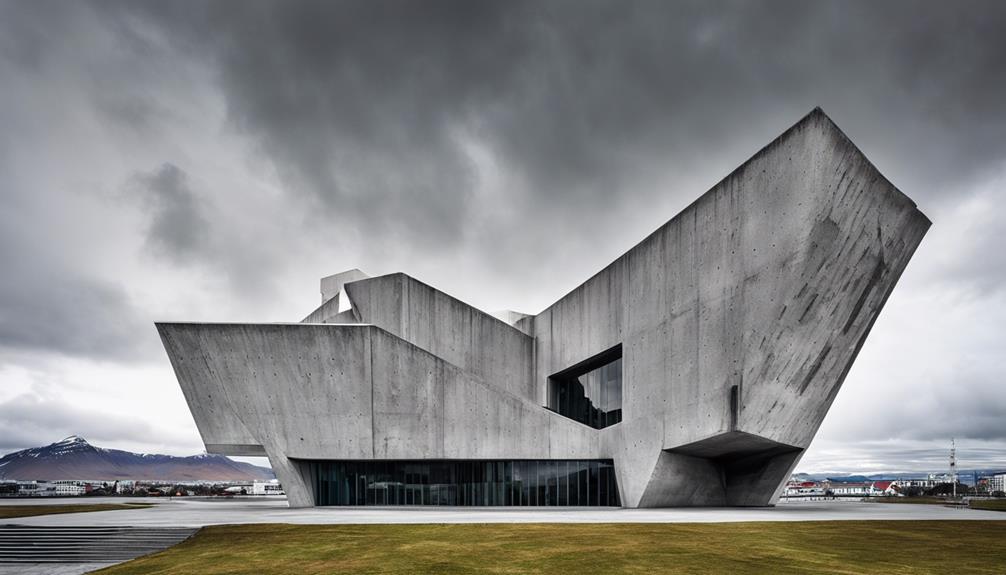
Nestled in the vibrant city of Reykjavík, Kjarvalsstaðir Art Museum captivates visitors with its immersive showcase of Icelandic artistic talent and its striking brutalist architectural design. Designed by the esteemed architectural firm LYX arkitekter, the museum stands as a testament to modern design within the architectural field.
Here are some key highlights of the Kjarvalsstaðir Art Museum:
- Renowned Icelandic Artists: The museum proudly displays the works of celebrated Icelandic artists, providing a rich tapestry of the country's creative legacy.
- Architectural Marvel: The building's modernist architecture with a brutalist aesthetic offers a unique backdrop for the displayed artworks, creating a harmonious blend of art and design.
- Cultural Hub: Visitors can immerse themselves in various exhibitions and cultural events, fostering a dynamic space for artistic exploration and dialogue.
- Tribute to Jóhannes Sveinsson Kjarval: Named after the esteemed artist, the museum pays homage to his legacy and contribution to Icelandic art.
- Innovative Experience: Kjarvalsstaðir Art Museum redefines traditional museum visits by offering a fresh, innovative approach to engaging with art and culture.
Frequently Asked Questions
Is the Brutalist House in Iceland Real?
Yes, the Brutalist House in Iceland is a conceptual design that captivates viewers with its innovative approach. It challenges traditional architectural norms by featuring a unique flipped container shape and panoramic glass walls for a 360-degree view.
Though some mistake it for a real structure due to its realistic presentation, the house design truly showcases creativity and imagination in architecture. It serves as a conversation starter for exploring new design concepts in the field.
How Much Is the Brutalist House in Iceland?
The Brutalist House in Iceland is listed for 180 million ISK. It offers a unique experience with a grotto-like swimming pool and a rooftop terrace. Designed by Högna Sigurðardóttir in 1963, the 308 sq m house overlooks Reykjavík.
It's available for rent on Airbnb for £407 per night. Marketed by Eignamiðlun, this architectural gem is a must-see for those seeking a blend of history and modernity.
Where Is the 45 Brutalist?
The 45 Brutalist House is uniquely located in Reykjavík, Iceland, boasting a design that stands out among architectural marvels. It was meticulously crafted by Högna Sigurðardóttir in 1963 and covers 308 sq m, showcasing distinctive features.
Notably, a spiral staircase leads to a captivating grotto-like swimming pool, adding to its allure. This house has rightfully garnered historical acclaim and prestigious awards for its exceptional design and remarkable preservation.
Which Country Has the Most Brutalist Architecture?
We believe the United Kingdom boasts the most significant collection of Brutalist architecture, showcasing iconic structures like the Barbican Estate and the Trellick Tower in London.
This architectural style, popularized in the mid-20th century as a response to Modernism, is characterized by raw concrete and bold geometric shapes.
Notable examples are also found in countries like Brazil, the United States, and France, contributing to the global impact of Brutalist design.
Conclusion
In conclusion, these 10 brutalist houses in Iceland are truly a sight to behold. From the striking geometric shapes to the raw concrete finishes, each house tells a story of creativity and innovation in architecture.
The juxtaposition of modern design against Iceland's natural landscapes creates a visually stunning experience for visitors.
So, if you're looking for a unique architectural adventure, be sure to add these iconic houses to your must-see list in Iceland.
- About the Author
- Latest Posts
Introducing Ron, the home decor aficionado at ByRetreat, whose passion for creating beautiful and inviting spaces is at the heart of his work. With his deep knowledge of home decor and his innate sense of style, Ron brings a wealth of expertise and a keen eye for detail to the ByRetreat team.
Ron’s love for home decor goes beyond aesthetics; he understands that our surroundings play a significant role in our overall well-being and productivity. With this in mind, Ron is dedicated to transforming remote workspaces into havens of comfort, functionality, and beauty.
-

 Vetted2 days ago
Vetted2 days ago15 Best Tile Sealers for Long-Lasting Protection and Shine
-

 Vetted7 days ago
Vetted7 days ago15 Best Smelling Floor Cleaners That Will Leave Your Home Fresh and Inviting
-

 Vetted4 days ago
Vetted4 days ago14 Best Power Scrubbers for Showers That Will Transform Your Cleaning Routine
-

 Appliances2 days ago
Appliances2 days ago5 Best Energy-Efficient Stainless Steel Fridges 2023
-

 Vetted3 weeks ago
Vetted3 weeks agoBest Mop for Sparkling Clean Floors in 2024
-

 Vetted2 days ago
Vetted2 days agoBest Essential Oil Brand: Top Picks for 2024
-

 Vetted7 days ago
Vetted7 days agoBest Space Heater for Your Home in 2024
-
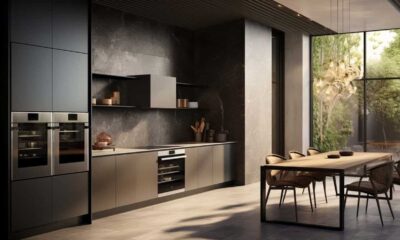
 Appliances14 hours ago
Appliances14 hours agoTop 6 Wi-Fi-Enabled Smart Kitchen Gadgets






